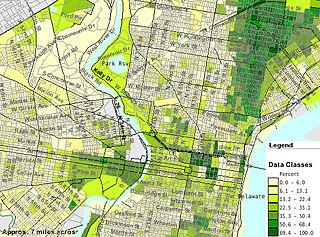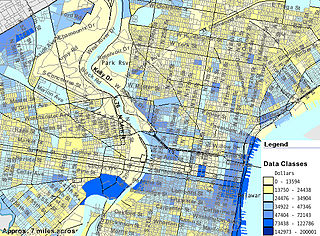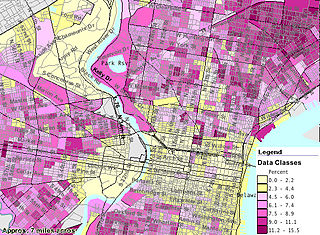- Demographics of Philadelphia
-
Historical populations Census Pop. %± 1790 28,522 — 1800 41,220 44.5% 1810 53,722 30.3% 1820 63,802 18.8% 1830 80,462 26.1% 1840 93,665 16.4% 1850 121,376 29.6% 1860 565,529 365.9% 1870 674,022 19.2% 1880 847,170 25.7% 1890 1,046,964 23.6% 1900 1,293,697 23.6% 1910 1,549,008 19.7% 1920 1,823,779 17.7% 1930 1,950,961 7.0% 1940 1,931,334 −1.0% 1950 2,071,605 7.3% 1960 2,002,512 −3.3% 1970 1,948,609 −2.7% 1980 1,688,210 −13.4% 1990 1,585,577 −6.1% 2000 1,517,550 −4.3% 2010 1,526,006 0.6% [1][2] As of the census[3] of 2000, there were 1,517,550 people, 590,071 households, and 352,272 families residing in the city of Philadelphia, Pennsylvania. The population density was 4,337.3/km² (11,233.6/mi²). There were 661,958 housing units at an average density of 1,891.9/km² (4,900.1/mi²).
The racial makeup of the city as of 2010 was:
- 44.2% Black
- 36.0% White
- 6.3% Asian
- 4.7% from other races
- 3.2% Mixed Race
- 0.2% Native American
- 0.05% Pacific Islander
- 12.5% of the population were Hispanic and Latino.
Of the 590,071 households, 27.6% had children under the age of 18 living with them, 32.1% were married couples living together, 22.3% had a female householder with no husband present, and 40.3% were non-families. 33.8% of all households were made up of individuals and 11.9% had someone living alone who was 65 years of age or older. The average household size was 2.48 and the average family size was 3.22.
The population was spread out with 25.3% under the age of 18, 11.1% from 18 to 24, 29.3% from 25 to 44, 20.3% from 45 to 64, and 14.1% who were 65 years of age or older. The median age was 34 years. For every 100 females there were 86.8 males. For every 100 females age 18 and over, there were 81.8 males.
The median income for a household in the city was $30,746, and the median income for a family was $37,036. Males had a median income of $34,199 versus $28,477 for females. The per capita income for the city was $16,509. 22.9% of the population and 18.4% of families were below the poverty line. 31.3% of those under the age of 18 and 16.9% of those 65 and older were living below the poverty line.
The male-female ratio was 86.8 to 100, with 46.5% of the population male and 53.5% female. Of places with 100,000 or more people, this was the third lowest in the United States. Only Gary, Indiana and Birmingham, Alabama had a higher proportion of women.[1]
Of housing units, 590,071 (89.1%) were occupied and 71,887 (10.9%) were vacant. Of occupied housing units, 349,633 (59.3%) were owner-occupied and 240,438 (40.7%) were renter-occupied.
The mean travel time to work was 32.0 minutes for workers 16 years of age and older. Residents of Center City, however, had much shorter commutes. Center City has the third largest downtown residential population in the country, and most walk to work.
63.97% of Philadelphians drove an automobile to work (including carpools), 25.93% commuted by public transit, 9.22% walked to work, and 0.88% commuted by bicycle. 35.74% of households did not have an automobile. The proportion of Philadelphians who do not commute by auto is high compared to most other American cities, although lower than the proportions in New York City and Washington, D.C.
Contents
Population history
 Mean travel time to work, 2000 Census. Note 1 to 22 minute commutes in Center City while some block groups in North Philadelphia exceed an hour. Low-wage service workers commonly travel to the suburbs for employment.
Mean travel time to work, 2000 Census. Note 1 to 22 minute commutes in Center City while some block groups in North Philadelphia exceed an hour. Low-wage service workers commonly travel to the suburbs for employment.
From its founding through the early 19th century, the City of Philadelphia was considered the area between the Delaware and Schuylkill Rivers and between Vine and South Streets. In 1854, the Act of Consolidation incorporated the rest of Philadelphia County and created Philadelphia's modern border. This resulted in a large population increase, evident in the 1860 census.
Philadelphia experienced steady growth between 1860 and 1950, except for a brief lull in 1930, which was due in part to the Great Depression. Its population peaked at 2,071,605 in 1950. Between 1950 and 2000, the city lost 554,055 people, or 26.7% of its population. To put this into perspective, Chicago lost 20.0% of its population during the same era, and Baltimore lost 31.4%, according to US Census data. This nationwide trend is often referred to as "white flight" because upper- and middle-class families, enabled by nationwide improvements to infrastructure, left cities in favor of their surrounding suburbs.
Estimates predict that the city will experience population growth slightly before or after 2010. These estimates and the reasons behind them are sources of great debate. Possible reasons for the turnaround include increases in immigration from foreign countries (especially from countries like India, South Korea and Mexico) and migration from more expensive cities in the Northeast Corridor. Both wealthy transplants and Asian American investors from New York City have received media attention for setting their sights on Philadelphia.[4][5][6] The ten-year tax abatement, a historically undervalued housing market, improvements to the waterfront, and continuing redevelopment throughout the city are thought to be factors drawing people to the area.
Ethnography
The largest concentrations of native-born blacks are in Germantown, the central, northern, and western neighborhoods of North Philadelphia, the Point Breeze neighborhood of South Philadelphia, parts of Southwest Philadelphia, and most of West Philadelphia. Together these neighborhoods have a population of about 610,000 and are roughly 82% black; making it the fourth largest predominantly black area in the United States after Bedford-Stuyvesant, Brooklyn, Detroit, and South Side Chicago. [2] Large concentrations of non-Hispanic whites live in Center City, Northeast Philadelphia, and Northwest Philadelphia (although this is changing). Gentrification is altering the racial demographics of predominantly black neighborhoods close to Center City.
Compared to its immigrant-magnet peers in the Northeast, Philadelphia has long been considered a "black and white" city of mostly native born African Americans and Whites. However the number of Hispanics and Asian Americans has increased over the past 20 years and continues to accelerate. The number of foreign-born residents increased by 34,000 between 1990 and 2000. Of foreign-born Philadelphians, 38.5% were from Asia, 30.3% were from Europe, 23.4% were from Latin America, and 6.7% were from Africa.
 Percent who spoke a language other than English at home, 2000 Census. Notable are Chinatown, international students in University City, and Hispanic Americans in eastern North Philadelphia.
Percent who spoke a language other than English at home, 2000 Census. Notable are Chinatown, international students in University City, and Hispanic Americans in eastern North Philadelphia.
Increases in Latino immigration and migration have fueled the growth of El Centro de Oro in Fairhill. As of 2010, Philadelphia has the second largest Puerto Rican community in the United States, after New York City.[citation needed] Puerto Ricans constitute over 75% of the Latino population in the city and most[quantify] live in the area that straddles the border between the North and Northeast sections of the city. Philadelphia has also seen strong increases among its Dominican and Mexican populations.[citation needed]
Mexican immigrants have drastically changed the Italian Market area in South Philadelphia and have set up a small community in and around the market. Today[when?] Mexicans are the third largest Hispanic community, after Puerto Ricans and Dominicans, both of who mainly reside in North Philadelphia.[citation needed]
The Asian American community has long been established in the city's bustling Chinatown district, but recent Vietnamese immigrants have also forged neighborhoods and bazaars alongside the venerable Italian market. Korean immigrants have notably added to the melting pot of Olney.[citation needed]
Irish immigrants and the Irish Americans are associated in the North and Northeast Philadelphia neighborhoods, including Fishtown, Kensington, Mayfair, Frankford, Port Richmond, Holmesburg, Harrowgate, and Juniata, as well as Devil's Pocket, Whitman, and Pennsport in South Philly in addition to many other areas.[citation needed]
Italian immigrants and the Italian American community are frequently associated with South Philadelphia as well as Bella Vista, Central South Philadelphia, Girard Estates, Marconi Plaza, Packer Park, the Italian Market area, and Tacony, among others. Poles and Polish Americans have a rich history in the Port Richmond-Bridesburg area, as well as areas of Kensington and the Northeast. Many other cultures can also be found throughout the city, including West Indians in the Cedar Park neighborhood, and many Russian, Greek and Ukrainian immigrants in the Near Northeast.[citation needed]
Recent immigrants from Asia are mainly of Indian, Korean, Chinese, Vietnamese, Laotian, Hmong, Filipino, Cambodian, Thai, Pakistani and Bangladeshi backgrounds. In addition, the Latino population continues to grow, as Dominican, Mexican, Colombian, Salvadoran, Guatemalan, Cuban, and Brazilian immigrants, as well as Puerto Rican citizens emigrate to the city. There are also a number of recent Ethiopian, Somali, and Sudanese immigrants from Northeast Africa.[citation needed]
Philadelphia has one of the most notable West African populations in the United States; the city counts many Liberian Americans and Nigerian Americans among its residents.[citation needed] By 2008 about 15,000 Liberians had immigrated to Philadelphia; the Liberians left their native country due to two civil wars and the destruction of Liberian infrastructure.[7] There is also a sizable community of Jamaicans and Haitians.
European immigration is also growing, with more Irish, Italian, and Polish immigrants. Recently[when?], thousands of Russian and Ukrainian immigrants from Eastern Europe (many of whom are Jewish) have arrived. There are other growing nationalities, which include Spanish, Portuguese, Slovak, Greek and Serbian.
The city's Middle Eastern population has tripled since 1990, with people of Palestinian, Turkish, Lebanese, Iranian, Egyptian, Iraqi, Saudi, Syrian and Afghan backgrounds residing in Philadelphia.
Religion
Christianity is the dominant religion in the city of Philadelphia. The largest denomination is Roman Catholic. Philadelphia's Jewish population, the sixth largest in the nation, was estimated at 206,000 in 2001 and almost 300,000 in 2009.[8] There is also a significant Eastern Orthodox population as well as a strong Lutheran community. In fact, the greater Philadelphia area is home to one of the largest Lutheran communities in America (The largest on the East Coast).[citation needed]
Many new religions have arrived, including Islam and Hinduism. With immigration from the Middle East, the Horn of Africa, Pakistan, Bangladesh and India, these two religions have increased their presence. The largest concentrations of Muslims and Hindus live in the Northeast and North parts of the city, Center City, West Philadelphia, and sprawling into the nearby suburbs.
Religions with less numerous adherents can also be found. There is Buddhism in Chinatown, and Caribbean and African traditional religions in North and West Philadelphia. These numbers are also growing. Historically the city has strong connections to The Religious Society of Friends, Unitarian Universalism, and Ethical Culture, all of which continue to be represented in the city. The Friends General Conference is based in Philadelphia.
The Muslim African American community in Philadelphia has grown substantially over the last decade.
References
- ^ Population of the 100 Largest Cities and Other Urban Places In The United States: 1790 to 1990
- ^ http://www.philly.com/philly/news/homepage/20091202_Hey__Philly__You_re_bigger_.html
- ^ "American FactFinder". United States Census Bureau. http://factfinder.census.gov. Retrieved 2008-01-31.
- ^ Pressler, Jessica (August 14, 2005). "Philadelphia Story: The Next Borough". The New York Times. http://select.nytimes.com/gst/abstract.html?res=F10B1FFC3A580C778DDDA10894DD404482. Retrieved May 1, 2010.
- ^ Muhammad, Nisa Islam. "D.C. ‘exodus’ sparks district renewal efforts for Whites", The Final Call, June 21, 2007. Accessed June 25, 2007.
- ^ "Washington's Black Majority Is Shrinking". The New York Times. September 16, 2007. http://www.nytimes.com/2007/09/16/us/16washington.html. Retrieved May 1, 2010.
- ^ Herold, Benjamin. "Student 'ambassadors' tackle divide between Africans, African Americans." The Notebook. Northern hemisphere Fall 2008. Volume 16, No. 1. 1. Retrieved on December 16, 2010.
- ^ "Philadelphia". Jewish Virtual Library.
Sources and further reading
- American Factfinder, US Census.
- Philadelphia in Focus: A Profile from Census 2000, Brookings Institution, November 2003.
- Licht, Walter (1992). Getting Work: Philadelphia, 1840-1950. Cambridge, Massachusetts, USA: Harvard University Press. ISBN 9780812217193.; LCCN 91-35021. A discussion of how Philadelphia workers found jobs and how employers found workers, including how the process was affected by race, ethnicity, origin (immigrant versus native-born), industrial sector, unionization, and other demographic differences.
City of Philadelphia Architecture · Companies · Culture · Cuisine · Demographics · Education · Fire department · History · Language · Law enforcement · Mayors · Media · Music · Neighborhoods · Notable people · Region · Sites of interest · Skyscrapers · Sports · Transportation
 Categories:
Categories:- Philadelphia, Pennsylvania
- Demographics of Pennsylvania
Wikimedia Foundation. 2010.



